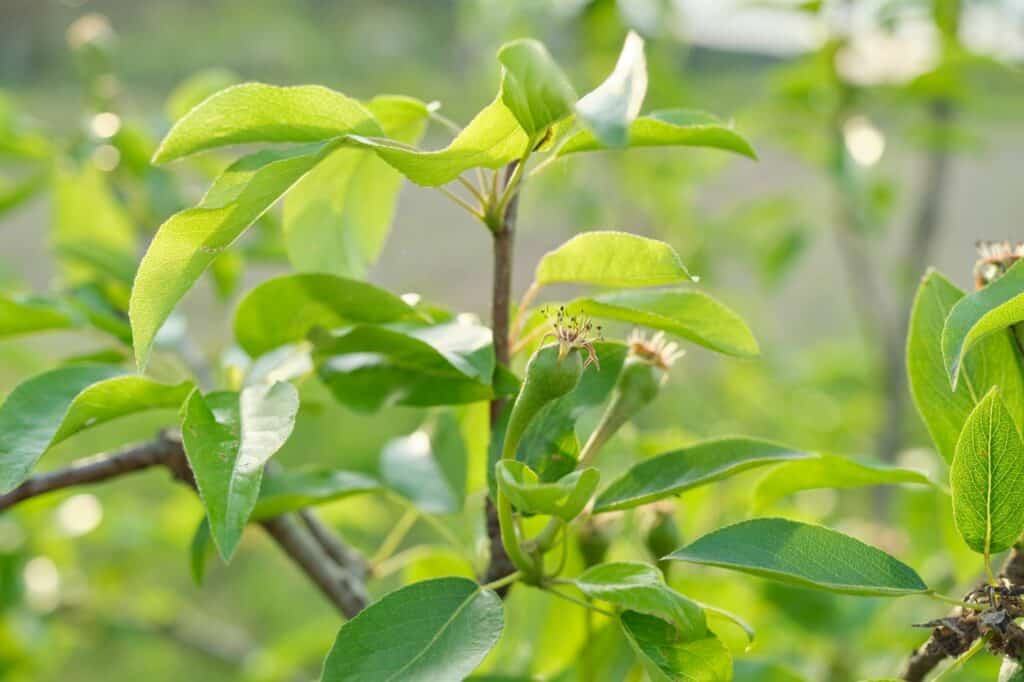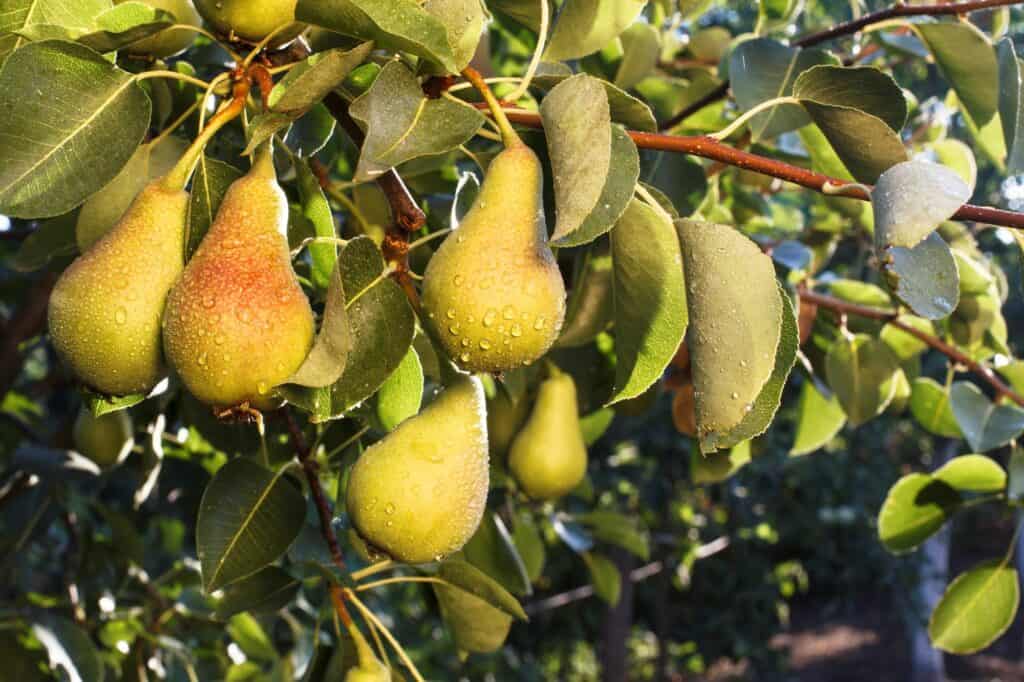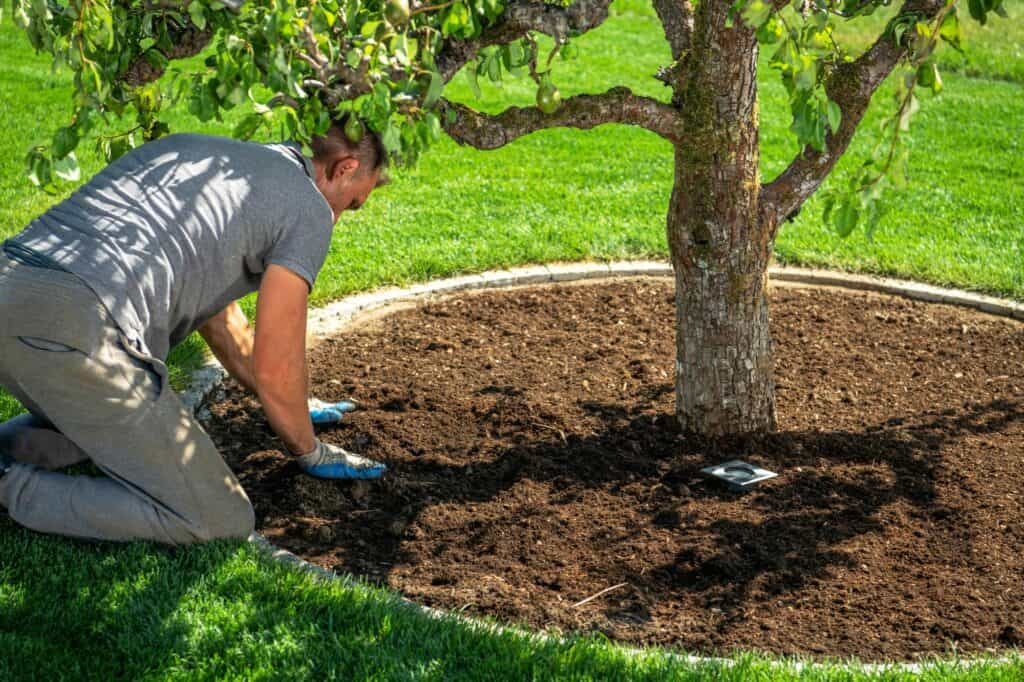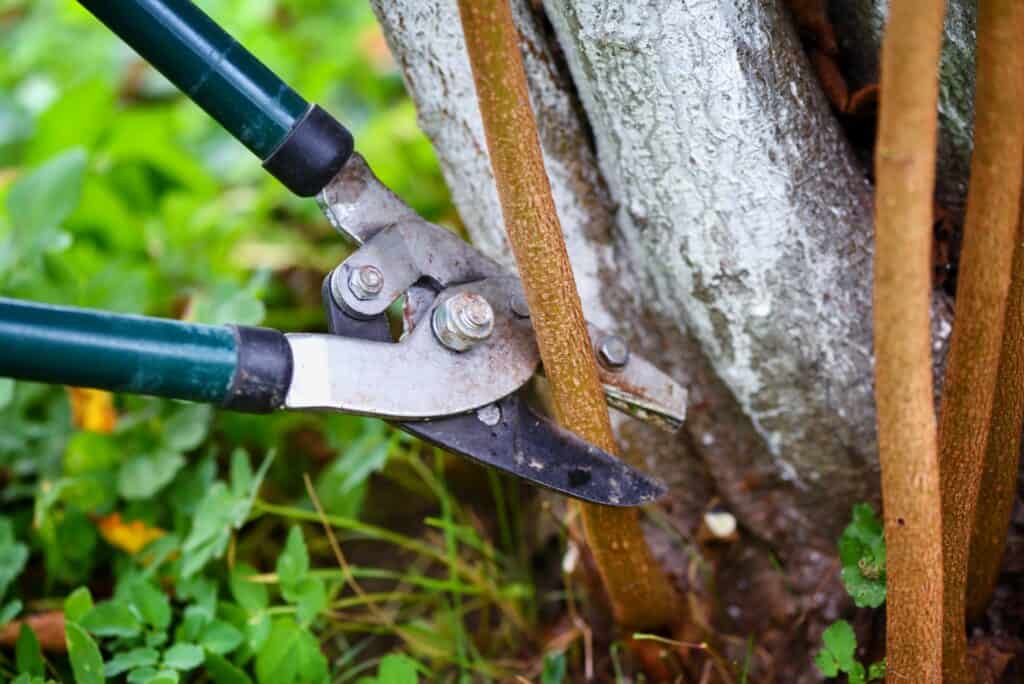Black spots on pear tree leaves are a common problem for many gardeners. These spots can be caused by a variety of factors, including diseases, insects, and environmental factors.
Understanding the causes of black spots on pear tree leaves is essential for effective prevention and treatment.
One of the most common causes of black spots on pear tree leaves is fungal and bacterial diseases. Fabraea leaf spot is a fungal infection that affects a range of fruiting trees from early spring to late summer.
Fire blight is a bacterial disease that can cause black spots on the leaves, as well as wilting and dieback of the branches. Identifying the specific disease causing the black spots is critical for effective treatment.
In addition to diseases, insects and pests can also contribute to black spots on pear tree leaves. Pear psylla is an insect that feeds on the leaves and can cause black spots as well as a sticky substance called honeydew.
Spider mites and aphids are other pests that can cause black spots on the leaves. Preventing and treating these pests is essential for maintaining the health of the pear tree.
Key Takeaways
- Black spots on pear tree leaves can be caused by diseases, insects, and environmental factors.
- Identifying the specific cause of the black spots is essential for effective treatment.
- Preventing and treating pests is crucial for maintaining the health of the pear tree.
Other related articles:
Black Spots on Fig Tree Leaves: 5 Causes, Treatments & Best Care Tips
Black Spots on Flower Leaves: 5 Causes, Treatment & Best Care Tips

Understanding Black Spots on Pear Tree Leaves
Black spots on pear tree leaves are a common sign of several fungal and bacterial diseases. These spots can vary in size and shape, and they are often accompanied by other symptoms such as leaf discoloration, blackening, and leaf drop.
In this section, we will explore the most common causes of black spots on pear tree leaves and how to prevent and treat them.
Fungal Diseases
Fungal diseases are the most common cause of black spots on pear tree leaves. Fabraea leaf spot, also known as black spot, is a fungal disease that causes pinpoint brown and black spots on pear tree leaves, fruit, and branches.
This disease is active in late May and early June, and excessive infection can lead to yellow and dropping leaves.
Another fungal disease that causes black spots on pear tree leaves is pear rust. This disease is characterized by orange spots on the upper side of the leaves and black spots on the lower side.
Bacterial Diseases
Fire blight is a bacterial disease that can cause blackening and discoloration of pear tree leaves. This disease is characterized by the sudden wilting and blackening of the leaves and twigs.
The bacteria responsible for fire blight can also cause black cankers on the branches, which can lead to dieback and death of the tree.
Environmental Factors
Environmental factors such as frost, drought, and excessive heat can also cause black spots on pear tree leaves.
Frost damage can cause blackening of the leaves and twigs, while drought stress can cause leaf discoloration and blackening. Excessive heat can also cause leaf drop and blackening of the leaves.
Prevention and Treatment
Preventing black spots on pear tree leaves involves proper tree care and maintenance. This includes pruning the tree to improve air circulation, watering the tree regularly, and applying fungicides and bactericides as needed.
If black spots are already present on the leaves, it is important to remove the infected leaves and branches and dispose of them properly. Fungicides and bactericides can also be applied to prevent further infection.
What Causes Black Spots on Pear Tree Leaves
Pear tree leaves with black spots can be a sign of various diseases. In this section, we will discuss some of the most common diseases that cause black spots on pear tree leaves.
1. Fire Blight
Fire blight is a bacterial disease caused by Erwinia amylovora. This disease can cause black or brown spots on pear tree leaves.
If left untreated, it can also affect the tree’s twigs, branches, and fruit. Fire blight is highly contagious and can spread quickly from tree to tree.
It is important to remove infected branches and twigs as soon as possible to prevent the spread of the disease.
2. Fabraea Leaf Spot
Fabraea leaf spot is a fungal disease caused by Fabraea maculata. This disease can cause pinpoint brown and black spots on pear tree leaves, fruit, and branches.
Usually, this disease is active in late May and early June, and excessive infection can lead to yellow and dropping leaves. Pruning while the tree is dormant is the best way to control this disease.
3. Pear Scab
Pear scab is a fungal disease caused by Venturia pirina. This disease can cause black spots on the leaves of pear trees.
The spots can also spread to the fruit, causing it to become misshapen and unappetizing. The best way to control this disease is to remove infected leaves and fruit as soon as possible.
4. Pear Rust
Pear rust is a fungal disease caused by Gymnosporangium sabinae. This disease can cause black spots on pear tree leaves, as well as yellow spots on the upper surface of the leaves and orange spots on the undersides.
The best way to control this disease is to remove infected leaves and fruit as soon as possible.
5. Sooty Blotch
Sooty blotch is a fungal disease caused by several species of fungi. This disease can cause black spots on the leaves of pear trees, as well as a black, sooty film on the fruit.
The best way to control this disease is to keep the tree’s foliage dry and to remove infected leaves and fruit as soon as possible.
6. Bacterial Diseases
Several bacterial diseases can cause black spots on pear tree leaves. In addition to fire blight, other bacterial diseases include bacterial leaf spot and bacterial canker.
These diseases can cause black or brown spots on the leaves, as well as cankers on the branches and trunk. The best way to control these diseases is to remove infected branches and twigs as soon as possible.

Insects and Pests Contributing to Black Spots
Black spots on pear tree leaves can be caused by various insects and pests. Here are some of the most common culprits:
Pear Psylla
Pear psylla is a small insect that feeds on the sap of pear trees. They are often found on the undersides of leaves and can cause yellowing and curling of leaves.
The feeding damage can lead to black spots on the leaves. The pear psylla also secretes a sticky substance called honeydew, which can attract other insects and lead to the growth of sooty mold.
To control pear psylla, it is important to monitor the trees regularly and remove any infested leaves or branches. Natural predators such as ladybugs and lacewings can also help to control the population. Insecticides can be used as a last resort.
Codling Moth
Codling moth is a common pest of pear trees that can cause black spots on the fruit and leaves. The adult moth lays its eggs on the fruit or leaves, and the larvae burrow into the fruit or leaves to feed. The feeding damage can lead to black spots on the leaves and fruit.
To control codling moth, it is important to remove and destroy any infested fruit or leaves. Pheromone traps can be used to monitor the population, and insecticides can be used as a last resort.
Pear Slug
Pear slug is a type of sawfly larvae that feeds on the leaves of pear trees. They are often found on the upper surface of the leaves and can cause skeletonization of the leaves. The feeding damage can lead to black spots on the leaves.
To control pear slug, it is important to monitor the trees regularly and remove any infested leaves. Natural predators such as birds and parasitic wasps can also help to control the population. Insecticides can be used as a last resort.
Mites
Mites are tiny arachnids that feed on the sap of pear trees. They are often found on the undersides of leaves and can cause yellowing and curling of leaves. The feeding damage can lead to black spots on the leaves. Mites can also cause the growth of sooty mold.
To control mites, it is important to monitor the trees regularly and remove any infested leaves or branches. Natural predators such as predatory mites and lacewings can also help to control the population. Insecticides can be used as a last resort.
Identifying and Diagnosing Black Spots
Pear trees are susceptible to various diseases that can cause black spots on their leaves. Identifying the cause of black spots is essential to determine the appropriate treatment. Here are some common causes of black spots on pear tree leaves:
Fabraea Leaf Spot
Fabraea leaf spot is a fungal disease that affects a range of fruiting trees, including pear trees. It is the most common culprit of black spots on pear tree leaves.
The symptoms of Fabraea leaf spot include circular spots with dark brown or black margins and a lighter center. The spots often appear on the lower leaves first and then spread to the upper leaves.
Over time, the spots can cause the leaves to turn yellow and fall off the tree. In severe cases, the disease can also infect the fruit, causing it to develop black spots.
Pear Scab
Pear scab is another fungal disease that can cause black spots on pear tree leaves. It usually affects the fruit more than the leaves, but in severe cases, it can also cause black spots on the leaves.
The symptoms of pear scab include soft black/green lesions on the fruit, leaves, and twigs that turn gray and crack with age. The lesions can cause the leaves to yellow and fall off the tree.
Fire Blight
Fire blight is a bacterial disease that can cause black spots on pear tree leaves. The symptoms of fire blight include lesions or lumps on the leaves, twigs, and branches.
The infected areas usually turn black and have a burnt appearance. Fire blight can also cause the fruit to develop black spots.
Other Causes
Other factors that can cause black spots on pear tree leaves include frost, lack of water, and other fungal infections, such as pear rust.
It is important to properly diagnose the cause of the black spots to determine the appropriate treatment.

Preventive Measures and Treatment
Pear trees are susceptible to a variety of diseases and pests that can cause black spots on the leaves. Preventive measures and treatment can help control the spread of these diseases and keep your pear tree healthy.
1. Pruning
Pruning is an important preventive measure to keep your pear tree healthy. Prune the tree regularly to remove dead or diseased branches, as these can be a source of fungal spores.
Use sharp pruning shears or a pruning tool to make clean cuts, and be sure to sterilize your tools between cuts to prevent the spread of disease.
2. Fungicides
Fungicides can be used to treat fungal diseases that cause black spots on pear tree leaves. Look for fungicides that contain copper or sulfur, as these are effective against a wide range of fungal diseases.
Follow the manufacturer’s instructions carefully when applying fungicides, and be sure to wear protective clothing and gloves to avoid skin contact.
3. Horticultural Oil
Horticultural oil can be used to smother pests that cause black spots on pear tree leaves. Look for horticultural oil that contains neem oil, as this is effective against a wide range of pests.
Apply the oil to the leaves and branches of the tree, being sure to cover all surfaces thoroughly.
4. Streptomycin
Streptomycin is an antibiotic that can be used to treat fire blight, a bacterial disease that causes black spots on pear tree leaves.
Follow the manufacturer’s instructions carefully when applying streptomycin, and be sure to wear protective clothing and gloves to avoid skin contact.
In addition to these treatments, it’s important to practice good prevention measures to keep your pear tree healthy. Water the tree regularly, and avoid getting water on the leaves.
Keep the area around the tree clean and free of debris, and avoid planting other susceptible plants nearby. With proper care and attention, your pear tree can thrive and produce healthy, delicious fruit.
Maintaining Pear Tree Health
Maintaining pear tree health is crucial to prevent the development of black spots on the leaves. The following tips can help keep pear trees healthy and free from disease:
- Water and fertilize properly: Pear trees require regular watering and fertilization to stay healthy. However, overwatering can lead to root rot, which can weaken the tree and make it more susceptible to disease. It is recommended to water the tree deeply once a week, and to fertilize it with a balanced fertilizer in early spring and midsummer.
- Prune regularly: Pruning is essential to remove dead or diseased branches, improve air circulation, and promote fruit production. It is best to prune the tree in late winter or early spring when it is still dormant.
- Maintain good air circulation: Good air circulation is crucial to prevent the development of fungal diseases. Planting pear trees in a location with good air circulation, and pruning regularly to remove crowded or crossing branches can help promote good air circulation.
- Prevent wind damage: Strong winds can damage the tree and make it more susceptible to disease. It is recommended to stake newly planted trees and to prune regularly to remove weak or damaged branches.
- Clean up fallen leaves and fruit: Fallen leaves and fruit can harbor disease-causing organisms, so it is important to clean them up regularly. Raking fallen leaves and fruit and disposing of them properly can help prevent the spread of disease.
- Monitor for signs of disease: Regularly inspecting the tree for signs of disease, such as black spots on the leaves or fruit, can help catch and treat diseases early. If the tree is showing signs of disease, it is recommended to consult an arborist for proper diagnosis and treatment.
By following these tips, pear tree owners can help maintain the health of their trees and prevent the development of black spots on the leaves.

Understanding the Impact of Black Spots
Black spots on pear tree leaves can be caused by various factors, including fungal and bacterial infections. These spots can have a significant impact on the health and productivity of the tree.
Fungal infections like Fabraea leaf spot can cause defoliation, which can weaken the tree and reduce its ability to produce fruit. In severe cases, the fungus can also cause cankers on the stems, which can lead to secondary infections and further damage.
Bacterial infections like fire blight can be even more damaging. This contagious disease can cause scorched and yellowing leaves, as well as cankers on the tree’s branches and trunk. If left untreated, fire blight can kill the entire tree.
In agriculture, black spots on pear tree leaves can be a major concern. If the tree is producing inedible fruit, it can significantly impact the harvest and the farmer’s bottom line.
Additionally, if the infection is contagious, it can spread to other trees in the orchard, leading to a widespread problem.
To prevent the spread of infections, it is important to disinfect pruning tools between cuts and remove any infected foliage from the area. It is also important to properly identify the cause of the black spots to determine the best course of treatment.
Frequently Asked Questions
What is the best treatment for black spots on pear tree leaves?
The best treatment for black spots on pear tree leaves depends on the cause of the spots. If the spots are caused by a fungal infection, then a fungicide may be necessary. If the spots are caused by fire blight, then pruning infected branches is necessary. It is recommended to consult a professional arborist or extension agent for proper diagnosis and treatment.
How can you prevent black spots from forming on pear tree leaves?
To prevent black spots from forming on pear tree leaves, it is important to maintain good tree health. This includes proper watering, fertilization, and pruning. It is also important to remove any infected leaves or branches to prevent the spread of disease.
What is the most effective fungicide for treating black spots on pear trees?
The most effective fungicide for treating black spots on pear trees depends on the specific type of fungus causing the spots. Some common fungicides for pear trees include copper-based fungicides, sulfur-based fungicides, and neem oil. It is important to follow the instructions on the fungicide label carefully.
What are some common causes of black spots on fruit trees?
Some common causes of black spots on fruit trees include fungal infections, bacterial infections, and environmental stressors such as drought or frost. Proper tree care and maintenance can help prevent these issues.
How do you identify and treat fire blight on a pear tree?
Fire blight on a pear tree can be identified by wilted leaves and blackened branches. Pruning infected branches and applying a copper-based fungicide can help treat fire blight.
What steps can you take to prevent black rot on pear trees?
To prevent black rot on pear trees, it is important to maintain good tree health by proper watering, fertilization, and pruning. It is also important to remove any infected leaves or branches to prevent the spread of disease. Applying a fungicide may also be necessary.

Hey, I’m Lisa and I’ve been an avid gardener for over 30 years. I love writing, talking and living in the garden! Feel free to connect with me on my socials below


